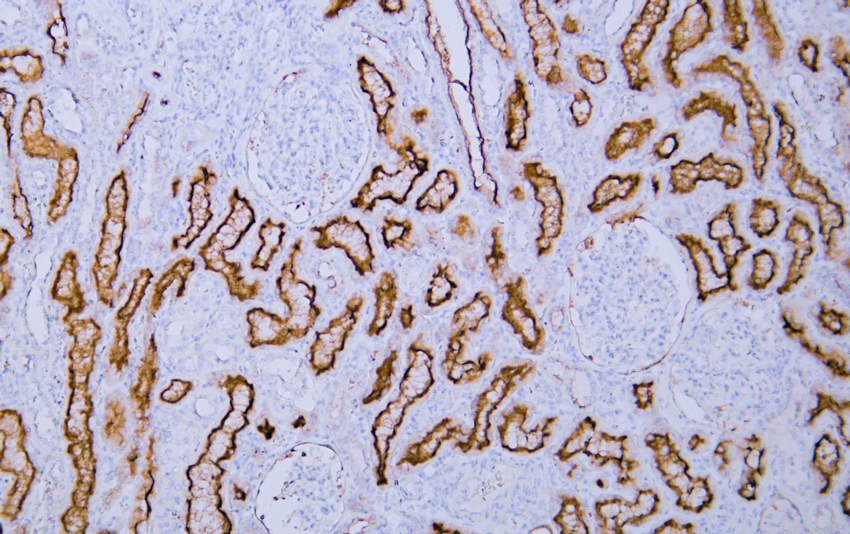MDR1 (ABT252) Mouse mAb (Ready to Use)
- Catalog No.:YM6976R
- Applications:IHC
- Reactivity:Human; Mouse;
- Target:
- MDR1
- Fields:
- >>ABC transporters;>>Bile secretion;>>MicroRNAs in cancer;>>Gastric cancer
- Gene Name:
- ABCB1 MDR1 PGY1
- Protein Name:
- ABC20;ABCB1;ATP binding cassette, sub family B (MDR/TAP), member 1;ATP-binding cassette sub-family B member 1;CD243;CLCS;Colchicin sensitivity;Doxorubicin resistance;GP170;MDR1;MDR1_HUMAN;Multidrug re
- Human Swiss Prot No:
- P08183
- Rat Swiss Prot No:
- P43245
- Immunogen:
- Synthesized peptide derived from human MDR1 AA range: 600-700
- Specificity:
- The antibody can specifically recognize human MDR1 protein.
- Formulation:
- PBS, pH7.2, 0.03% Porcolin 300, containing stabilizing protein
- Source:
- Mouse, Monoclonal/IgG1, Kappa
- Dilution:
- Ready to use for IHC
- Purification:
- The antibody was affinity-purified from mouse ascites by affinity-chromatography using specific immunogen.
- Storage Stability:
- 2°C to 8°C/1 year
- Other Name:
- ABC20;ABCB1;ATP binding cassette, sub family B (MDR/TAP), member 1;ATP-binding cassette sub-family B member 1;CD243;CLCS;Colchicin sensitivity;Doxorubicin resistance;GP170;MDR1;MDR1_HUMAN;Multidrug resistance 1;Multidrug resistance protein 1;P glycoprotein 1;P gp;P-glycoprotein 1;PGY1
- Molecular Weight(Da):
- 141kD
- Background:
- The membrane-associated protein encoded by this gene is a member of the superfamily of ATP-binding cassette (ABC) transporters. ABC proteins transport various molecules across extra- and intra-cellular membranes. ABC genes are divided into seven distinct subfamilies (ABC1, MDR/TAP, MRP, ALD, OABP, GCN20, White). This protein is a member of the MDR/TAP subfamily. Members of the MDR/TAP subfamily are involved in multidrug resistance. The protein encoded by this gene is an ATP-dependent drug efflux pump for xenobiotic compounds with broad substrate specificity. It is responsible for decreased drug accumulation in multidrug-resistant cells and often mediates the development of resistance to anticancer drugs. This protein also functions as a transporter in the blood-brain barrier. [provided by RefSeq, Jul 2008],
- Function:
- catalytic activity:ATP + H(2)O + xenobiotic(In) = ADP + phosphate + xenobiotic(Out).,disease:Genetic variations in ABCB1 are associated with susceptibility to inflammatory bowel disease type 13 (IBD13) [MIM:612244]. Inflammatory bowel disease is characterized by a chronic relapsing intestinal inflammation. It is subdivided into Crohn disease and ulcerative colitis phenotypes. Crohn disease may involve any part of the gastrointestinal tract, but most frequently the terminal ileum and colon. Bowel inflammation is transmural and discontinuous; it may contain granulomas or be associated with intestinal or perianal fistulas. In contrast, in ulcerative colitis, the inflammation is continuous and limited to rectal and colonic mucosal layers; fistulas and granulomas are not observed. Both diseases include extraintestinal inflammation of the skin, eyes, or joints. Crohn disease and ulcerative col
- Subcellular Location:
- Membranous
- Expression:
- Kindey
- June 19-2018
- WESTERN IMMUNOBLOTTING PROTOCOL
- June 19-2018
- IMMUNOHISTOCHEMISTRY-PARAFFIN PROTOCOL
- June 19-2018
- IMMUNOFLUORESCENCE PROTOCOL
- September 08-2020
- FLOW-CYTOMEYRT-PROTOCOL
- May 20-2022
- Cell-Based ELISA│解您多样本WB检测之困扰
- July 13-2018
- CELL-BASED-ELISA-PROTOCOL-FOR-ACETYL-PROTEIN
- July 13-2018
- CELL-BASED-ELISA-PROTOCOL-FOR-PHOSPHO-PROTEIN
- July 13-2018
- Antibody-FAQs
- Products Images

- Human kidney tissue was stained with Anti-MDR1 (ABT252) Antibody



